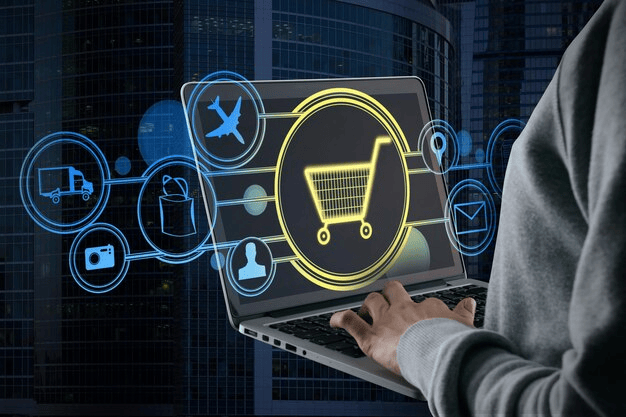The world of online commerce is evolving, and the advent of Web3 is set to revolutionize the way we engage in e-commerce. In this blog post, we’ll delve into the fundamentals of Web3, explore its benefits for businesses, outline the key features of a Web3-based e-commerce website, and provide a step-by-step guide on how to create a Web3 Ecommerce platform. Additionally, we’ll discuss how brands can prepare for Web3 and explore the future trends shaping the e-commerce landscape.
Understanding Web3 Ecommerce
Web3 development services represent the third generation of the World Wide Web, introducing a fully decentralized architecture built on blockchain technology. Unlike its predecessor, Web2, which is characterized by centralized control and ownership of data, Web3 empowers users, offering greater control over personal information and fostering peer-to-peer interactions. Let’s delve into the key differences between Web3 and Web2:
- Ownership of Data: In Web3, users have control and ownership of their data, a departure from Web2 where data is often owned by centralized authorities.
- Decentralization: Web3 eliminates central points of control, ensuring a more distributed and decentralized ecosystem compared to the centralized nature of Web2.
- Interoperability: Web3 is designed to be more interoperable, allowing different blockchain-based solutions to seamlessly interact with each other.
- Security: Leveraging blockchain and smart contracts, Web3 aims to provide enhanced security, reducing the risk of fraud and unauthorized access.

Benefits of Web3 for E-commerce:
The adoption of Web3 technologies in e-commerce brings forth a myriad of benefits for businesses. Let’s explore the most significant advantages:
- Decentralized E-commerce: Operate without intermediaries, reducing fees and increasing profits. Web3 enables businesses to operate in regions with strict regulations or limited access to traditional financial systems.
- Trustlessness: Web3 facilitates trustless transactions, leveraging blockchain for immutability, transparency, and cryptographic security, protecting buyers and sellers against fraud and data manipulation.
- Transparency: Web3 ensures transparent transactions that are easily traceable and auditable, beneficial for regulatory compliance and maintaining transparency with customers.
- Improved Security: Enhanced security features provided by blockchain technology contribute to a more secure e-commerce platform.
- Faster Transactions: Web3 transactions are faster than traditional payment operations, allowing businesses to process orders more quickly and efficiently.
- Greater User Control: Web3 empowers users by providing greater control over their data, reducing the risk of data breaches.
- Reduced Reliance on Intermediaries: Utilizing smart contracts and blockchain technology eliminates the need for intermediaries, reducing fees and simplifying payment workflows.
- Global Accessibility: Web3 removes geographical barriers, allowing anyone with internet access to participate in the marketplace.
- Incentivized Participation: Tokenization systems incentivize user participation, fostering a more engaged and active community.
- Enhanced Product Authenticity and Traceability: Blockchain ensures an immutable audit trail, verifying the authenticity and provenance of products.
- Greater Resilience and Censorship Resistance: Decentralized platforms are less susceptible to censorship and shutdowns, protecting arbitrary decisions that could negatively impact sellers or buyers.

Key Features of a Web3 Ecommerce Website:
To harness the benefits of Web3, your e-commerce website should incorporate the following key features:
- Decentralized Payment Gateways: Utilize decentralized payment gateways for peer-to-peer transactions, reducing the need for intermediaries and ensuring security.
- Smart Contracts: Implement smart contracts for escrow services, facilitating secure transactions without the involvement of intermediaries.
- P2P Trading: Enable direct interactions between buyers and sellers without intermediaries, leveraging platforms like Ethereum for decentralized applications.
- Decentralized Storage: Utilize decentralized storage solutions like IPFS for improved security, reliability, and privacy.
- NFT Integration: Embrace the popularity of NFTs by integrating them into your e-commerce platform, offering unique digital assets on the blockchain.
- Blockchain-based Identity: Implement a decentralized identity system built on blockchain to verify and authenticate users on your platform.
Web3 Tools and Frameworks
To streamline the development of your Web3 E-commerce platform, leverage the following tools and frameworks:
- Ethereum: A decentralized platform supporting smart contracts and DApps, with tools like Solidity, Remix, Truffle, and Web3.js.
- IPFS: InterPlanetary File System for distributed file storage and sharing.
- Ethereum DApp: Embark A development framework for Ethereum DApp development.
- OpenZeppelin: An open-source Web3 framework for building secure smart contracts on Ethereum.
- Polkadot.js: Libraries and tools for building applications on the Polkadot network.
- Truffle Suite: An integrated development environment and framework for Ethereum development.
- Web3.js: A JavaScript library for interacting with Ethereum and other compatible blockchains.
- Hardhat: A development environment and framework for building and testing smart contracts on Ethereum.
Steps to Creating a Web3 E-Commerce Platform
Now, let’s break down the process of building a Web3 e-commerce platform into 10 essential steps:
- Define your goals and objectives.
- Choose a suitable blockchain platform (e.g., Ethereum, Polkadot).
- Design the architecture, considering scalability, security, and user experience.
- Develop smart contracts to govern platform logic.
- Build a user-friendly front end interface using frameworks like React, Angular, or Vue.js.
- Integrate blockchain functionalities using web3.js or similar libraries.
- Implement decentralized storage protocols like IPFS.
- Enable secure payments with cryptocurrency wallets or payment gateways.
- Implement essential e-commerce features such as product searching, filtering, reviews, and order tracking.
- Thoroughly test and deploy your Web3 e-commerce platform on the chosen blockchain.

Preparing for Web3 E-commerce:
To prepare for the future of Web3 E-commerce, brands should consider the following strategies:
- Invest in blockchain technology to embrace transparency, security, and cost-effectiveness.
- Embrace cryptocurrency payments to expand the customer base and stay ahead of competitors.
- Explore the potential of NFTs to create unique products and experiences on the blockchain.
- Prioritize user privacy by utilizing decentralized platforms that ensure data protection.
- Stay informed about the latest developments in Web3 eCommerce and blockchain technology.
The Future of Web3 in E-commerce
Web3 Ecommerce holds the potential to revolutionize the industry, offering secure and instant payments, eliminating intermediaries, and creating a more trustworthy and transparent online environment. Future trends in Web3 E-commerce development include:
- Metaverse Integration: Web3 technologies can lay the foundation for building the infrastructure, protocols, and economies within the metaverse, creating immersive online experiences.
- Artificial Intelligence Synergy: Web3 and AI can complement each other, leading to the development of decentralized AI and fostering transparency, democratization, and prevention of single points of failure.
Several companies are already leveraging Web3 E-commerce technology for innovative solutions:
- OpenSea: A decentralized marketplace for NFTs, running on the Ethereum blockchain, allowing secure and transparent buying and selling.
- Origin Protocol: A decentralized e-commerce platform enabling payments without middlemen, featuring a reputation system and dispute resolution.
- Gnosis Safe: A secure wallet service for decentralized applications, providing easy interaction with tokens, NFTs, and digital assets on the Ethereum blockchain.
Conclusion:
As the landscape of online commerce evolves, embracing Web3 E-commerce is a strategic move for businesses aiming to enhance transparency, security, and user empowerment. By following the outlined steps and staying informed about the latest trends, brands can position themselves at the forefront of the Web3 revolution, ensuring a more inclusive, secure, and transparent future for e-commerce.






